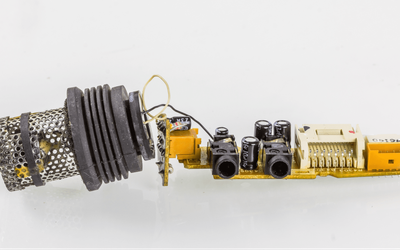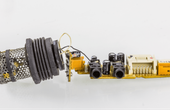Infineon Technologies XENSIV™ DPS368 Pressure Sensor Kit2Go
A high-precision pressure sensor development kit with an integrated temperature sensor designed for IoT and embedded systems.
Specifications
| Product | Evaluation Kit |
| Type | Pressure Sensor |
| For Evaluation Of | DPS3682 |
| Interface Type | I2C |
| Operating Supply Voltage | 3.3 V, 5 V |
| Operating Temperature | -40 to 85 °C |
| Applications | Automotive, Weather Monitoring, Industrial, Altimeter, Smart Home, Heating, Ventilation, and Robotics |
Overview
The onboard DPS368 pressure sensor can measure pressures from 300 to 1200 hPa and temperatures from -40°C to 85°C. The kit has a pressure-temperature sensitivity of 0.5 Pa/K and a temperature accuracy of ±0.5°C. Pressure Sensor Kit2Go also features a micro USB Type AB connector, two user LEDs, and one power LED. The kit is compatible with the Arduino IDE, allowing users to develop applications measuring pressure and temperature. Typical applications include automotive, industrial, robotics, altitude measurement, environmental monitoring, and smart home.
DPS368 Pressure Sensor Kit2Go Features
The XENSIV™ DPS368 Pressure Sensor Kit2Go is a swift way to start pressure sensor development. The kit has an Infineon XMC1100 microcontroller, which is based on the Arm Cortex-M0+ processor and has a clock speed of 48 MHz. The kit offers a DPS368 sensor breakout board and a USB cable for connecting the board to a computer. The kit is compatible with the Arduino IDE, making it swift to develop applications that involve pressure and temperature sensing.
The DPS368 sensor is a miniaturized digital barometric air pressure sensor with a capacitive sensing principle. The sensor is capable of measuring pressure with an accuracy of ±2 cm. This makes it suitable for applications where high precision is required, such as altitude measurement or weather forecasting. The sensor consumes only 20μΑ in active mode, which makes it usable in battery-powered applications. The sensor can be interfaced with the XMC1100 microcontroller using the I²C or SPI interface.
The kit has a FIFO result that can store up to 32 measurement results. This allows the sensor to store measurements while the microcontroller is busy with other tasks. The sensor is pre-calibrated, and the calibration coefficients are stored in the sensor. Users can calibrate it for their specific applications.
The kit includes a number of example Arduino sketches to get started with program development. These sketches demonstrate the use of the DPS368 sensor to measure pressure, temperature, and altitude. The kit also includes a software library that provides functions for reading and writing sensor data and calculating pressure, temperature, and altitude.
Getting Started with DPS368 Pressure Sensor Kit2Go
Here are the steps on how to use the evaluation kit:
1. Install the software library in Arduino IDE from the website to start using it.
2. Connect the sensor to the microcontroller board using the I²C or SPI interface.
3. Write a program to read the sensor data or use the sample codes in the library.
4. Run the program to display the sensor data on a computer or display device.
Applications
The DPS310/368 Pressure Sensor 2Go Kit is best used for applications including automotive, weather monitoring, robotics, altitude measurement, environmental monitoring, smart home, heating, ventilation, and air conditioning (HVAC). The kit can be used to measure air quality, blood pressure, hiking, mountaineering, aviation, and industrial manufacturing in daily life applications.
Where to find it

Mouser Electronics
Mouser Electronics is a worldwide leading authorized distributor of semiconductors and electronic components.









